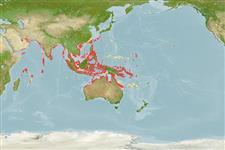Lớp phụ Cá sụn (cá mập và cá đuối) (sharks and rays) >
Myliobatiformes (Stingrays) >
Myliobatidae (Eagle and manta rays)
Etymology: Aetomylaeus: Greek, aetos = eagle + Greek, mylio = mill, grinder (Ref. 45335).
More on author: Gray.
Environment: milieu / climate zone / depth range / distribution range
Sinh thái học
Biển; Thuộc về nước lợ Cùng sống ở rạn san hô; Mức độ sâu 1 - 18 m (Ref. 37816). Tropical; 30°N - 23°S, 51°E - 167°E
Indo-West Pacific: India to China and Indonesia.
Length at first maturity / Bộ gần gũi / Khối lượng (Trọng lượng) / Age
Maturity: Lm 63.0, range 54 - 72 cm
Max length : 200 cm WD con đực/không giới tính; (Ref. 30573)
With distinctive color pattern and exceptionally long spineless tail over six times the length of the body (Ref. 37816).
Found inshore (Ref. 9862). Inhabits mangrove creeks and protected sandy channels to a depth of at least 18 m; relatively uncommon (Ref. 37816). Active swimmer, travelling long distances; feeds on crustaceans and molluscs (Ref. 68964). Ovoviviparous (Ref. 50449). Caught occasionally by bottom trawl, tangle net and inshore gillnet fisheries. Utilized for its meat, but of limited value as it is not frequently landed (Ref. 58048). Presumably utilized for human consumption in the western central Pacific (Ref. 9862).
Life cycle and mating behavior
Chín muồi sinh dục | Sự tái sinh sản | Đẻ trứng | Các trứng | Sự sinh sản | Ấu trùng
Exhibit ovoviparity (aplacental viviparity), with embryos feeding initially on yolk, then receiving additional nourishment from the mother by indirect absorption of uterine fluid enriched with mucus, fat or protein through specialised structures (Ref. 50449).
Mould, B., 1994. A world list of rays. The scientific nomenclature and distribution of the recent Batoidea (Batoidea, Elasmobranchii, Chondrichthyes). University of Nottingham, [UK]. 82 p. (Ref. 8630)
IUCN Red List Status (Ref. 130435)
Threat to humans
Traumatogenic
Human uses
Các nghề cá: buôn bán nhỏ
Thêm thông tin
Các tài liệu tham khảoNuôi trồng thủy sảnTổng quan nuôi trồng thủy sảnCác giốngDi truyềnElectrophoresesDi sảnCác bệnhChế biếnNutrientsMass conversion
Các công cụ
Special reports
Download XML
Các nguồn internet
Estimates based on models
Preferred temperature (Ref.
123201): 25.6 - 29.3, mean 28.6 °C (based on 2218 cells).
Phylogenetic diversity index (Ref.
82804): PD
50 = 0.5078 [Uniqueness, from 0.5 = low to 2.0 = high].
Bayesian length-weight: a=0.00389 (0.00123 - 0.01235), b=3.08 (2.82 - 3.34), in cm total length, based on LWR estimates for this (Sub)family-body shape (Ref.
93245).
Mức dinh dưỡng (Ref.
69278): 3.8 ±0.5 se; based on size and trophs of closest relatives
Thích nghi nhanh (Ref.
120179): thấp, thời gian nhân đôi của chủng quần tối thiểu là 4.5 - 14 năm (Fec assumed to be <100).
Fishing Vulnerability (Ref.
59153): Very high vulnerability (83 of 100).
